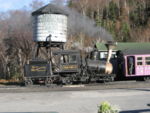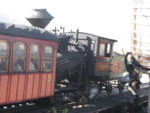
Green Mountain Cog Railway
Encyclopedia
The Green Mountain Cog Railway was a narrow gauge mountain railway
built to carry tourists to the top of Green Mountain (now known as Cadillac Mountain
) on Mount Desert Island
in Maine
.
. Construction of the railway started in 1883, and it was built to the designs in the Marsh patents developed for the Mount Washington line. The first locomotive was built by the Manchester Locomotive Works
, and was meant to be for the Mount Washington line. After the first season, Frank Clergue, "owner and operator", bought another coach and locomotive, both identical to their predecessors. The coaches and work cars were built by the Hinckly & Egery Iron Co. The coaches had eight benches, with open air seating that could hold six. During bad weather, canvas tarps were rolled down from the ceiling to protect the passengers from the wind and rain. The #1 locomotive was named "Mount Desert", and #2 was just named #2. Both locomotives were used at the same time when there were large numbers of passengers. There were no switches on the railway, so the trains did not have the ability to pass each other.
The line operated during the summer season and for the first few years was successful. But tourist numbers declined, and after the 1890 season the railway ceased operations. The railway's two steam locomotive
s were sold to the Mount Washington Cog Railway in 1895 after five years of disuse.
Mountain railway
A mountain railway is a railway that ascends and descends a mountain slope that has a steep grade. Such railways can use a number of different technologies to overcome the steepness of the grade...
built to carry tourists to the top of Green Mountain (now known as Cadillac Mountain
Cadillac Mountain
Cadillac Mountain is a mountain located on Mount Desert Island, within Acadia National Park. With an elevation of , its summit is the highest point in Hancock County, and the highest within of a coastline on the U.S. East Coast as well as down to the Yucatán Peninsula.-History:Before being renamed...
) on Mount Desert Island
Mount Desert Island
Mount Desert Island , in Hancock County, Maine, is the largest island off the coast of Maine. With an area of it is the 6th largest island in the contiguous United States. Though it is often claimed to be the third largest island on the eastern seaboard of the United States, it is actually second...
in Maine
Maine
Maine is a state in the New England region of the northeastern United States, bordered by the Atlantic Ocean to the east and south, New Hampshire to the west, and the Canadian provinces of Quebec to the northwest and New Brunswick to the northeast. Maine is both the northernmost and easternmost...
.
History
At the end of the 19th century, Maine's tourist industry was developing rapidly. The islands off the coast of Maine were popular attractions, and the possibility of a cog railway to the top of Green Mountain was first explored in the late 1870s, following the success of the Mount Washington Cog Railway in New HampshireNew Hampshire
New Hampshire is a state in the New England region of the northeastern United States of America. The state was named after the southern English county of Hampshire. It is bordered by Massachusetts to the south, Vermont to the west, Maine and the Atlantic Ocean to the east, and the Canadian...
. Construction of the railway started in 1883, and it was built to the designs in the Marsh patents developed for the Mount Washington line. The first locomotive was built by the Manchester Locomotive Works
Manchester Locomotive Works
Manchester Locomotive Works was a manufacturing company located in Manchester, New Hampshire, that built steam locomotives in the 19th century. The first locomotive they built was for the Chicago, Burlington and Quincy Railroad in March 1855. In 1901, Manchester and seven other locomotive...
, and was meant to be for the Mount Washington line. After the first season, Frank Clergue, "owner and operator", bought another coach and locomotive, both identical to their predecessors. The coaches and work cars were built by the Hinckly & Egery Iron Co. The coaches had eight benches, with open air seating that could hold six. During bad weather, canvas tarps were rolled down from the ceiling to protect the passengers from the wind and rain. The #1 locomotive was named "Mount Desert", and #2 was just named #2. Both locomotives were used at the same time when there were large numbers of passengers. There were no switches on the railway, so the trains did not have the ability to pass each other.
The line operated during the summer season and for the first few years was successful. But tourist numbers declined, and after the 1890 season the railway ceased operations. The railway's two steam locomotive
Steam locomotive
A steam locomotive is a railway locomotive that produces its power through a steam engine. These locomotives are fueled by burning some combustible material, usually coal, wood or oil, to produce steam in a boiler, which drives the steam engine...
s were sold to the Mount Washington Cog Railway in 1895 after five years of disuse.
Locomotives
| Number | Name | Image | Builder | Type | Date | Notes |
|---|---|---|---|---|---|---|
| 1 |  |
Manchester Locomotive Works Manchester Locomotive Works Manchester Locomotive Works was a manufacturing company located in Manchester, New Hampshire, that built steam locomotives in the 19th century. The first locomotive they built was for the Chicago, Burlington and Quincy Railroad in March 1855. In 1901, Manchester and seven other locomotive... |
1883 | Became No. 4 Chocorua of the Mount Washington Cog Railway | ||
| 2 |  |
Manchester Locomotive Works Manchester Locomotive Works Manchester Locomotive Works was a manufacturing company located in Manchester, New Hampshire, that built steam locomotives in the 19th century. The first locomotive they built was for the Chicago, Burlington and Quincy Railroad in March 1855. In 1901, Manchester and seven other locomotive... |
1883 | Became the Mount Washington Cog Railway No. 3 Agiocochook. |

